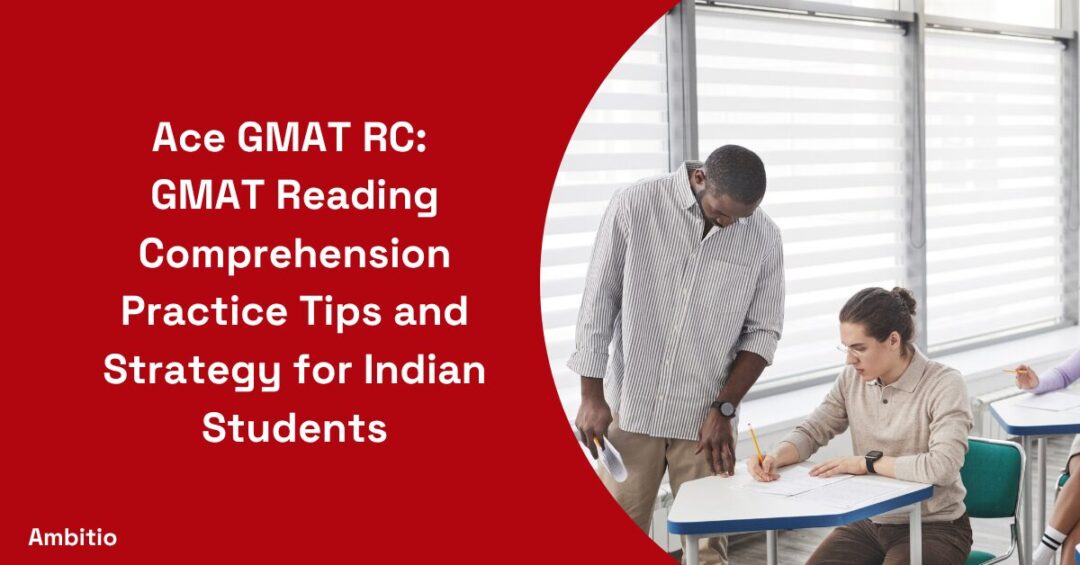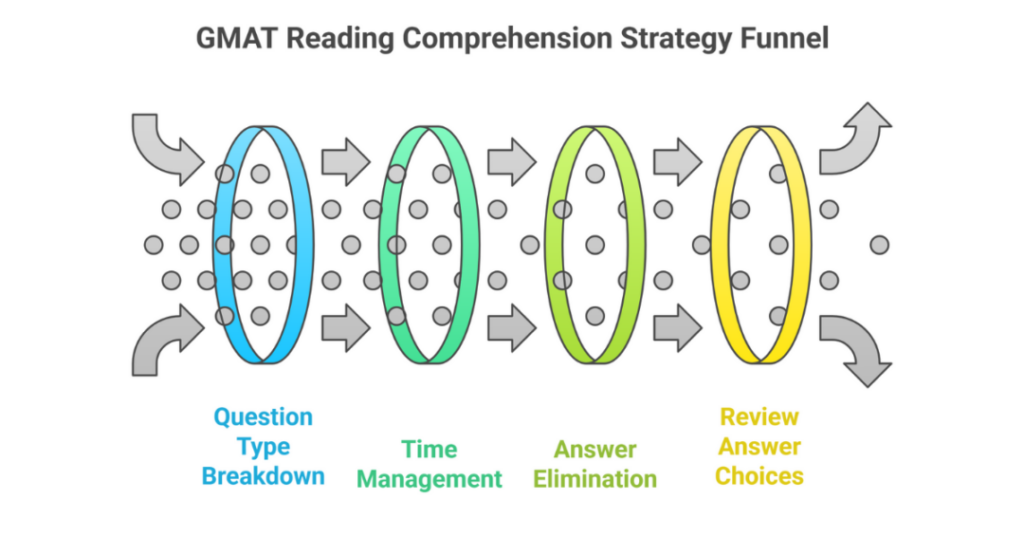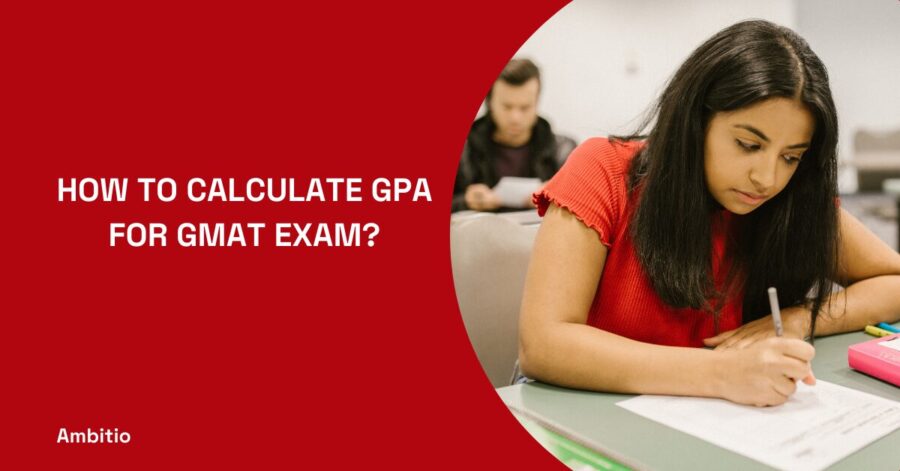16 June 2025
5 minutes read
Ace GMAT RC: GMAT Reading Comprehension Practice Tips and Strategy for Indian Students

Key Takeaways
- GMAT RC success starts with mastering reading comprehension questions using official guides and strategic keyword mapping.
- GMAT RC improvement hinges on eliminating four wrong answers and understanding each answer choice structure.
- GMAT RC becomes manageable when you read the passage for structure, not detail, and practice daily with timed drills.
Preparing for the GMAT can feel like an uphill climb, especially for Indian students juggling busy schedules and high expectations. One of the trickiest parts?
GMAT Reading Comprehension (RC). This section throws dense, jargon-filled passages your way and asks you to do the impossible: read fast, understand everything, and pick the one right answer from four convincing wrong ones. But here’s the twist—you can ace GMAT RC.
With the right GMAT plan, a sharp reading plan, and targeted GMAT prep, even the most complex GMAT RC passage will start making sense.
This guide covers everything from types of reading comprehension questions to practice questions, critical reasoning, and how to fall in love with RC passages. Whether you’re working with a tutor or grinding through official guides solo, this one’s got your back.
What is GMAT Reading Comprehension?
Did you know that some GMAT test-takers spend more time on Reading Comprehension than any other verbal question type?
- GMAT RC consists of reading comprehension passages followed by 3-4 multiple-choice questions.
- Topics range from science to history, economics to literature.
- The verbal section includes RC as one of its three main components, along with Sentence Correction and Critical Reasoning.
- Each RC question tests your ability to comprehend the passage, evaluate the author’s argument, and infer information.
- You will encounter at least four RC passages in the verbal section.

Comparison Table: Verbal vs GMAT Reading Comprehension
| Feature | Verbal Section | GMAT RC |
|---|---|---|
| Components | Sentence Correction, CR, RC | Only Reading Comprehension |
| Time Allocation | ~65 minutes total | ~30 minutes (approx.) |
| Passage Length | Varies | 200-350 words |
| Question Type | 3 types | Inference, Detail, Main Idea |
| Skills Tested | Grammar, Logic, Reading | Reading and Comprehension |
How to Attempt GMAT RC Passage?
Fun fact: Skimming an RC passage isn’t just a trick—it’s a science-backed GMAT reading strategy!
- Read the passage with purpose. Don’t try to memorize—comprehend the structure and main idea.
- Identify the author’s tone and intent early.
- Highlight keywords and phrases that signal structure: “however,” “in contrast,” “for example.”
- Don’t overthink vocabulary. Focus on context rather than exact definitions.
- Tackle the questions after you’ve read the whole passage to avoid tunnel vision.
GMAT Strategy to Improve Your GMAT Reading Comprehension
Believe it or not, eliminating four incorrect answers is sometimes easier than finding the right answer.
- Practice with official GMAT RC questions regularly.
- Break down each question type: inference, detail, main idea, tone, and structure.
- Time yourself while practicing to simulate exam pressure.
- Use an answer elimination plan to rule out incorrect answer choices.
- Review every answer choice—even the wrong ones—to understand why they’re incorrect.

GMAT RC Table:
| Strategy | Description |
| Eliminate Four | Remove clearly wrong answers first |
| Keyword Mapping | Map key topics and sentences |
| Answer Choice Justification | Explain why the correct answer is right |
| Practice with Timing | Simulate real-time RC question sessions |
| Use Official Guides | Stick to Graduate Management Admission Council™ material |
Practice Questions of Reading Comprehension Passages
Ever noticed how every answer choice sounds right? That’s the GMAT RC trap!
- Passage: The author discusses how economic sanctions rarely lead to regime change but often harm the civilian population.
- Question: What can be inferred from the passage?
- A. Sanctions often overthrow governments
- B. Sanctions primarily impact leaders
- C. Sanctions rarely result in regime change (Correct)
- D. Sanctions never hurt civilians
- Question: What can be inferred from the passage?
- Passage: The study on whales shows they communicate using frequencies not detectable by human ears.
- Question: What is the main idea of the passage?
- A. Whales have sophisticated communication (Correct)
- B. Whales swim in groups
- C. Humans can’t hear underwater
- D. Whale songs are just noise
- Question: What is the main idea of the passage?
- Passage: Unlike the previous question of climate change urgency, this one debates the economic implications of global policies.
- Question: What is the author’s tone?
- A. Passionate
- B. Neutral (Correct)
- C. Emotional
- D. Sarcastic
- Question: What is the author’s tone?
- Passage: Some researchers argue that AI will replace human jobs, others claim it will create more employment.
- Question: Which of the following best describes the structure?
- A. Argument with rebuttal (Correct)
- B. Pure narration
- C. Chronological
- D. Biographical
- Question: Which of the following best describes the structure?
- Passage: The article explores how bees communicate using dance.
- Question: Which is discussed in the passage?
- A. Bees pollinate flowers
- B. Bees produce honey
- C. Bees use movement to share information (Correct)
- D. Bees are endangered
- Question: Which is discussed in the passage?
How to Fall in Love With Your GMAT Reading Comprehension Practice?
Here’s a secret: RC doesn’t have to be boring if you know how to make it your favorite GMAT section!
- Pick passages on topics you enjoy—start with science or history if that’s your thing.
- Set daily RC goals and reward yourself.
- Turn wrong answers into learning moments.
- Track your progress to stay motivated.
- Read outside the GMAT—think The Economist, Nature, and historical journals.
Why is it Important to Reach Out to Official GMAT Verbal and Reading Comprehension Questions?
Would you train for Wimbledon using ping pong paddles? Neither should you prep with unofficial material.
- GMAC provides the best examples of what you’ll face in the actual exam.
- Official questions reflect the tone, structure, and difficulty level of the exam.
- Helps you understand the sentence structure commonly used.
- Reduces surprises on test day.
- Builds confidence using authentic material.
Can I Skim Through Questions While Practicing?
Skimming isn’t laziness; it’s efficiency, when done right.
- Skim the entire passage first to grasp the main idea.
- Focus more on topic sentences and keywords.
- Avoid deep reading unless the question demands it.
- Skim questions too—look for keywords that hint at what to find.
- Always re-read part of the passage to find specific answers.
Conclusion
You made it! If you’ve reached this far, you’re already executing a solid GMAT plan.
GMAT reading comprehension passage may seem like a dense forest of information in the passage, but with effective tips and plans, the right tutor, and official GMAT prep resources, you can turn it into your favorite GMAT paragraph.
Remember to read the passage with purpose, comprehend rather than memorize, and eliminate four wrong answers before selecting your correct answer. Don’t shy away from difficult questions—they teach you more than easy ones ever will.
Lean into the structure, master every answer choice, and use RC questions from the official guides. Fall in love with the RC passage, highlight every sentence, and treat every question type like a new adventure.
This GMAT verbal journey will not just help you improve your GMAT reading comprehension; it will help you excel in your graduate management admission council™ journey, from your letter of recommendation and statement of purpose to your personal statement and resume.
Whether you’re also juggling IELTS, TOEFL, ACT, GRE, SAT, or the EA (Executive Assessment), this RC blueprint has you covered. And hey, if you’re struggling, that’s normal. What matters is how you respond.
So skip the excuses with Ambitio, beware the traps, and let the GMAT reading comprehension practice begin!
FAQs
What is GMAT RC and why is it important for the GMAT verbal section?
GMAT RC is a crucial component of the GMAT verbal section that evaluates your ability to read, understand, and analyze complex academic passages effectively.
How many GMAT RC passages appear in the GMAT exam?
There are typically 4 GMAT RC passages in the GMAT exam, each followed by 3 to 4 reading comprehension questions.
What is the best way to prepare for GMAT RC questions?
The best way to prepare for GMAT RC questions is to practice with official GMAT material and build a consistent reading strategy focused on structure and inference.
How much time should I spend on each GMAT RC passage?
You should aim to spend around 6 to 8 minutes per GMAT RC passage, balancing your time between reading and answering all related questions.
Can skimming help improve accuracy in GMAT RC?
Yes, skimming can improve efficiency in GMAT RC, especially when combined with smart keyword tracking and selective re-reading for detailed questions.
Are there any proven strategies to eliminate wrong answers in GMAT RC?
Effective GMAT RC strategies include eliminating extreme options, matching choices to the author’s tone, and cross-checking with evidence in the passage.
Why should I use official GMAT material for GMAT RC practice?
Official GMAT resources provide realistic GMAT RC questions that reflect actual exam difficulty and improve your ability to comprehend complex paragraph structures.

You can study at top universities worldwide!
Get expert tips and tricks to get into top universities with a free expert session.
Book Your Free 30-Minute Session Now! Book a call now




























